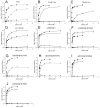Distinct roles of beta1 metal ion-dependent adhesion site (MIDAS), adjacent to MIDAS (ADMIDAS), and ligand-associated metal-binding site (LIMBS) cation-binding sites in ligand recognition by integrin alpha2beta1
- PMID: 18820259
- PMCID: PMC3329621
- DOI: 10.1074/jbc.M802066200
Distinct roles of beta1 metal ion-dependent adhesion site (MIDAS), adjacent to MIDAS (ADMIDAS), and ligand-associated metal-binding site (LIMBS) cation-binding sites in ligand recognition by integrin alpha2beta1
Abstract
Integrin-ligand interactions are regulated in a complex manner by divalent cations, and previous studies have identified ligand-competent, stimulatory, and inhibitory cation-binding sites. In collagen-binding integrins, such as alpha2beta1, ligand recognition takes place exclusively at the alpha subunit I domain. However, activation of the alphaI domain depends on its interaction with a structurally similar domain in the beta subunit known as the I-like or betaI domain. The top face of the betaI domain contains three cation-binding sites: the metal-ion dependent adhesion site (MIDAS), the ADMIDAS (adjacent to MIDAS), and LIMBS (ligand-associated metal-binding site). The role of these sites in controlling ligand binding to the alphaI domain has yet to be elucidated. Mutation of the MIDAS or LIMBS completely blocked collagen binding to alpha2beta1; in contrast mutation of the ADMIDAS reduced ligand recognition but this effect could be overcome by the activating monoclonal antibody TS2/16. Hence, the MIDAS and LIMBS appear to be essential for the interaction between alphaI and betaI, whereas occupancy of the ADMIDAS has an allosteric effect on the conformation of betaI. An activating mutation in the alpha2 I domain partially restored ligand binding to the MIDAS and LIMBS mutants. Analysis of the effects of Ca(2+), Mg(2+), and Mn(2+) on ligand binding to these mutants showed that the MIDAS is a ligand-competent site through which Mn(2+) stimulates ligand binding, whereas the LIMBS is a stimulatory Ca(2+)-binding site, occupancy of which increases the affinity of Mg(2+) for the MIDAS.
Figures






References
Publication types
MeSH terms
Substances
Grants and funding
LinkOut - more resources
Full Text Sources
Other Literature Sources
Miscellaneous

